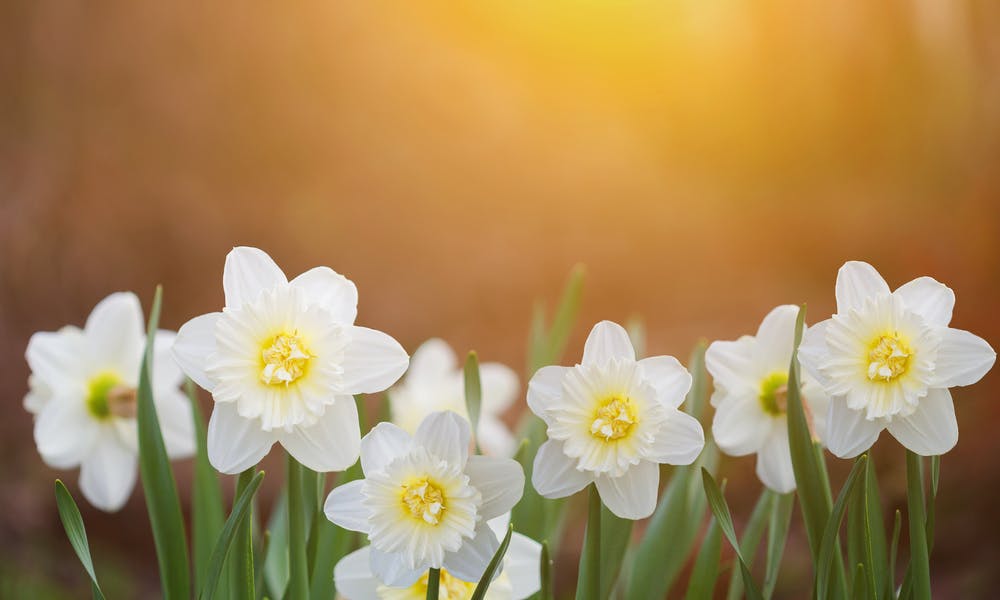Jonquil flowers, scientifically known as narcissus jonquilla, are spring-flowering bulbs that you can plant in the sun. The shape of this flower, and its heady scent, make it an excellent plant to place indoors and outdoors.
Jonquil flowers arrived in Europe during the Renaissance. They are easy to grow in pots or the ground. You can even force the bulbs to bloom early in the season and enjoy their sweet fragrance for the festive period. Jonquils are available in many shades that you can beautifully mix with other spring bulbs. The jonquil is a rustic bulb that you love to plant in your backyard or your living room. Jonquils thrive from November to May.
They tolerate soils that are a little heavy and wet and can return to bloom in spring. For more advanced floral arrangements, consider double-flowered narcissus.
Discover more interesting points on this article:
* Description
* Planting
* Pot cultivation
* Care and Maintenance
* Watering
* Pests and Diseases
Description
There are more than 100 varieties of narcissus. Jonquils are part of the narcissus. The flower is called “narcissus jonquilla” and has small, fragrant, yellow trumpet-shaped flowers. Also, this bulbous perennial is very hardy and reaches 40 cm in height. You can easily recognize this beautiful flower in the garden. It cannot go unnoticed.
The genus narcissus belongs to the amaryllidaceae family. It includes 50 species of bulbous plants and multiple cultivars that are popular in spring gardens for their trumpet, cup, and wreath blooms. There are varieties with arranged or solitary flowers, single or very double, deliciously fragrant, or scentless. The sap from all narcissi is poisonous if consumed and can provoke skin irritation or allergies.
Narcissus jonquilla comes originally from Spain. The name means “little rush,” refers to its narrow, semi-cylindrical, and erects leaves. The flowers do not exceed three cm in diameter and have a small flattened crown and pointed segments.
Planting
We advise you to plant jonquil plants in autumn as they bloom in spring. To allow the bulbs to develop before the last frosts, planting in the open ground begins between October and November.
Outdoors, it would be best if you planted the jonquils in the sun in cool but not humid soil. If the soil is too clayey, add sand to the planting holes. Place the bulbs in well-tilled, stone-free soil. Dig holes about 10 to 15 cm deep and place the bulbs 15 cm apart.
Do not pack the soil too tightly by closing the holes and water a little. Jonquil likes sun or semi-shade exposure. However, these bulbous perennials like fresh earth. Clay soils are not a problem. You can plant jonquils everywhere. In beds, they easily associate with grasses, as well as other flowering perennials. Pot planting is entirely possible and can be carried out between September and November.
Pot Cultivation
Jonquils grow very well in pots and planters. Proceed in the same way and place your containers in the sun or half-shade. Don’t forget the clay balls in the bottom of the pots to avoid too much humidity.
Try to take advantage of the jonquils in the fall. Plant a bulb halfway down in the light soil of a pot. Water carefully and place the jar in a cold, dark room for three to four weeks.
The temperature should not exceed 10 degrees. Then move the pot to a darker, warmer place, about 18 degrees. After a week, the flowers can appear. Avoid situations in full sun and too close to radiators!
Care and Maintenance
For jonquil in the garden, let the leaves wilt before cutting them and leave the bulbs in the ground until the next season. If you want to keep your bulbs for a long time, pull them out once all the leaves are well browned, store them in the shade after brushing them lightly. You can replant the jonquil bulbs next fall.
After flowering, cut off the wilted flower. The leaves are used to store the bulb’s reserves so that it can blossom the following year again. Feel free to apply fertilizers.
Narcissus does not require any additional special maintenance, not even watering in summer. If your jonquils are forced and potted, cut off the flower stems and keep the foliage green by watering lightly and regularly. Store the pot in the light but not in a warm place. Plant the bulbs in the garden or another large container.
Watering
Jonquil maintenance is simple: add a little manure in winter and remove the leaves when they are yellow, but not before, as this could harm its growth.
Your wilted jonquils can be cut down to the ground, so you can have the chance to see them grow the following winter again. For group plantings, remember to loosen the bulbs in September every two or three years.
Moderate watering is appropriate so as not to soak the bulbs, which would cause them to rot.
Pests and Diseases
Like most bulbous plants, jonquils can be the target of two very annoying garden pests: slugs and snails! However, you can easily repel them with egg-shell barriers, or eliminate them with beer traps.
Fungal diseases can also harm jonquils, especially if they are over-watered or if the soil that receives them is too wet or poorly drained.
The jonquil flower consists of many varieties such as the “daffodil” (Narcissus jonquilla), which delights our gardens from February onwards. Although the jonquils have a relatively short flowering period, about 15 days, you can appreciate its small tufts of color while the tulips have not yet come out. The flowers thrive when the sun is shining. To extend this blooming period, do not hesitate to plant bulbs in less sunny areas to enjoy them until May. The magnificent jonquil narcissus offers a delightful spectacle, making it a must-have flower in the springtime borders!
